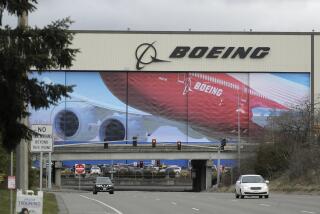3 Top Industrial Unions Expected to Seek Merger
- Share via
DETROIT — The nation’s three largest industrial unions--representing about 2 million auto workers, steelworkers and machinists--are expected to propose a merger of their memberships today in Washington.
The merger would join the United Auto Workers, United Steelworkers of America and the International Assn. of Machinists & Aerospace Workers and create the nation’s largest union with vast financial and political clout.
According to labor sources, the proposed merger is expected to take as long as five years to complete and would be modeled after the powerful IG Metall union, which represents metalworkers in industries throughout Germany.
“These are serious talks between the nation’s three largest industrial unions,” said one union official. “It’s fair to say that their combination would create a powerhouse industrial union.”
The precise details of the proposed merger were not clear Wednesday. But sources said it most likely would involve a federation in which the unions would maintain their identities while sharing finances, resources and political strategies.
If completed, the combined union would be larger than the National Education Assn., now the nation’s biggest union, which represents roughly 1.8 million teachers nationwide. The auto workers union represents about 800,000 members, steelworkers about 700,000 and the machinists 500,000.
Representatives of the three unions would not comment other than to say the presidents of the three unions--the UAW’s Stephen Yokich, the USWA’s George Becker and IAM’s George Kourpias--would “make an announcement that will impact the future of the labor movement.”
But sources inside and outside the labor movement said the unions would formally announce the beginning of talks to hammer out the details of a merger. These negotiations could take months and any merger would ultimately have to be approved by each union’s members.
“This would clearly be the largest and most important merger in recent history, certainly in the post-World War II era,” said Harley Shaiken, a labor professor at UC Berkeley. “It would be a powerhouse in resources and reach.”
The proposed merger comes as the labor movement is reeling from sagging membership and political clout. The combined membership of the three unions is about half of what it was 20 years ago.
In the last year, the unions unsuccessfully fought the North American Free Trade Agreement and were unable to get legislation barring companies from hiring permanent replacement workers during a strike.
In the face of such setbacks, some union leaders have advocated mergers as a way to consolidate power and pool resources. While union mergers have been going on for years, the process has recently speeded up. Most recently the steelworkers absorbed the rubber workers union and the International Ladies’ Garment Workers’ Union merged with the Amalgamated Clothing and Textile Workers Union.
In addition, the UAW and the machinists, which both represent aerospace workers, have held occasional merger talks in recent years, labor officials said.
The latest union marriage proposal comes against a backdrop of turmoil within the labor movement. In recent months, impatient and frustrated union leaders have sought to shake up the labor hierarchy.
The UAW, steelworkers and machinists are part of a group that recently called for the retirement of Lane Kirkland as president of the AFL-CIO, whom they criticized as being too passive and lacking fresh ideas.
They are all backing John Sweeney, president of the Service Employees International Union, for the post against Kirkland’s pick, Thomas Donahue, the current secretary-treasurer of the AFL-CIO, which is the umbrella organization representing most of the U.S. labor movement.
“This merger is a further manifestation of some of the fermentation in the labor movement,” said Shaiken. “It shows how they are looking for broad strokes and are reaching out for new visions.”
Although it is not clear who is pushing hardest for a merger, the proposal comes just a month after Yokich took the helm of the UAW. A combative and feisty leader, Yokich has advocated the formation of a broad-based metalworkers federation similar to Germany’s powerful industrial union.
“We will continue seeking partners for a merger,” Yokich told reporters in Detroit in May. “We feel we should have a North American metalworkers federation.”
Yokich also wants to bring Canadian and Mexican workers into the fold. He said such a move is needed to protect and enhance living standards in all three countries and to enable unions to negotiate with corporations on an equal footing in the wake of NAFTA, he said.
Shaiken said a merger of this size would give the unions a boost in their efforts to organize workers as well as increase their lobbying and political clout in Washington and state capitals.
“This is a not a merger that amounts to circling the wagons,” he said, “but one that reaches out for a larger role for labor.”
More to Read
Sign up for Essential California
The most important California stories and recommendations in your inbox every morning.
You may occasionally receive promotional content from the Los Angeles Times.













